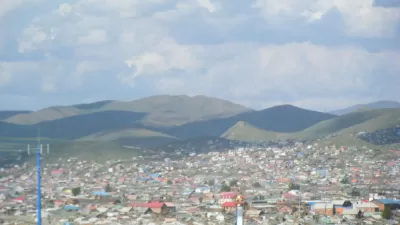Ulaanbaatar, the capital of Mongolia, was planned by the Russian government in the 1950s with extensive infrastructure and lush city parks. That infrastructure is deteriorating, while more of the nomadic population move to the city to survive.
40% of Mongolians are nomadic, following their herds around the countryside and living out of yurts (tent-like homes). That way of life is becoming harder to maintain, and the nomads are finding they must move to the capital to survive, moving into "yurt districts."
Sarah Bassett writes about Ulaanbaatar's history: "During Soviet occupation, the first master plan for Ulaanbaatar was developed and began its implementation in the 1950s, following with revisions in urbanization policy guaranteeing the planting of gardens and trees and provision of municipal services. By the 1980s, Ulaanbaatar was a vibrant city flush with park space, community friendly courtyards, functioning roadways, and infrastructure maintenance. It has been during the past twenty years that a massive change in the conditions of the city has occurred."
FULL STORY: Post-Soviet Urbanism in Mongolia, by Sarah Bassett

Trump Administration Could Effectively End Housing Voucher Program
Federal officials are eyeing major cuts to the Section 8 program that helps millions of low-income households pay rent.

Planetizen Federal Action Tracker
A weekly monitor of how Trump’s orders and actions are impacting planners and planning in America.

Ken Jennings Launches Transit Web Series
The Jeopardy champ wants you to ride public transit.

California Invests Additional $5M in Electric School Buses
The state wants to electrify all of its school bus fleets by 2035.

Austin Launches $2M Homelessness Prevention Fund
A new grant program from the city’s Homeless Strategy Office will fund rental assistance and supportive services.

Alabama School Forestry Initiative Brings Trees to Schoolyards
Trees can improve physical and mental health for students and commnity members.
Urban Design for Planners 1: Software Tools
This six-course series explores essential urban design concepts using open source software and equips planners with the tools they need to participate fully in the urban design process.
Planning for Universal Design
Learn the tools for implementing Universal Design in planning regulations.
Ada County Highway District
Clanton & Associates, Inc.
Jessamine County Fiscal Court
Institute for Housing and Urban Development Studies (IHS)
City of Grandview
Harvard GSD Executive Education
Toledo-Lucas County Plan Commissions
Salt Lake City
NYU Wagner Graduate School of Public Service



























